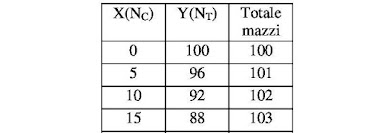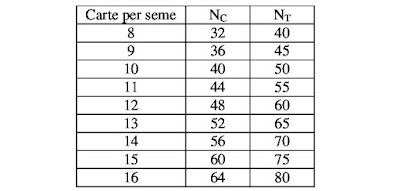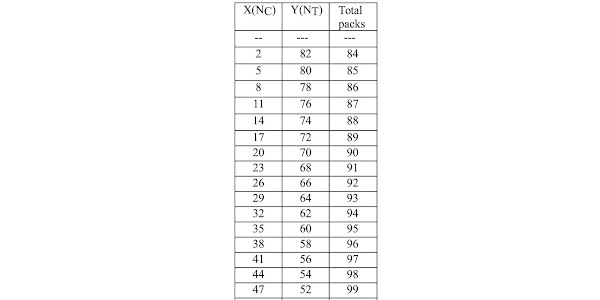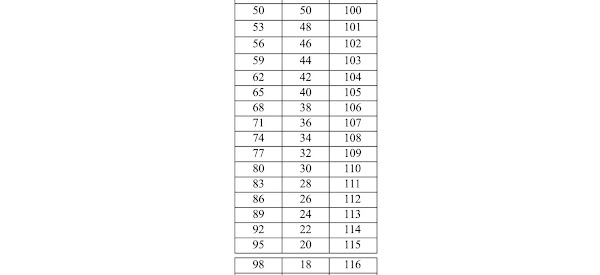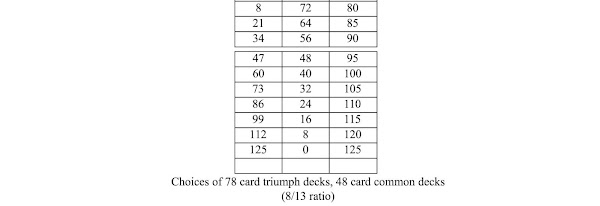However I have been studying Pythagorean number theory a bit lately. That might help. So at Huck’s urging (viewtopic.php?f=11&t=1100#p18158) I am taking the plunge. After many hours of puzzling over it, I think it is Franco who is confused. That is a rather strong claim, I know, and another reason for hesitating to translate it. One of us is wrong, and I will be even more embarrassed if it is me. But I can’t let fear of shame and dishonor stand in the way of truth. In another post I will try to explain what he is doing (for the arithmetically challenged) and what I think is wrong. Below, in the translation, as usual comments in brackets are by me, and the page numbers correspond to the original, "1477: Bologna – Aritmetica per carte e trionfi", at http://www.naibi.net/A/323-BONOZZI-Z.pdf.
1477 Bologna: Arithmetic for cards and triumphs
Franco Pratesi – 09.06.2014
Introduction
The idea for writing this note comes from rereading an article published more than a century ago, which directed attention, among other things, to an important Bolognese document of 1477. (1) A copy of the original article with some comments is even available on the Internet. (2) It is a well known text variously commented on by several experts. Some deductions derived from that information seem to have to be revised; others are better understood with a different assessment; others seem to me would require further thought and reflection.
The justification for submitting these reflections to the attention of the experts is that ultimately I have provided many new numbers for card games that should be granted to me from reasoning a bit on the old numbers supplied by others.
The Data
The earliest documents found in the archives of Bologna and published by Orioli represented very early evidence, such as to lead many experts to consider Bologna a very important center for the production of playing cards, beginning from their first diffusion. It is not easy to judge if such a conclusion is due to the fact that similar documentation in other cities and for previous periods. had not yet been found
But if we consider that the use of playing cards was already common for some time (for example in Florence at least from the beginning of 1377, so much so that the councilors concerned were induced to prohibit its further spread), the possible Bologna priority is reduced at most to the use of the woodcut as an important part of the production.
German card makers
From the point of view of woodcuts, still more significant is the large presence of German card makers among those documented in Bologna. It is known that the craft of woodworking for reproduction of pictures was very advanced in the regions of central and southern Germany and adjacent areas. It seems that all the oldest woodcuts that have come down to us stem from one area or another of so-called Mitteleuropa.
At this point it seems to me that the question is reduced to one alternative for resolution: did German playing card makers export to the rich Italian cities the production of playing cards or did they just flock to Italy because a production already widespread could take advantage of their technical expertise in woodworking?
Here the date becomes decisive, which is old only only in relation to others noted, but not so much as to suggest the introduction of new and original items. In my view the same phenomenon happened with playing cards as occurred with the manufacture of shoes: German shoemakers were very capable and easily found a new and abundant clientele in Italy, (3) but it is not legitimate to draw the consequence that in our cities shoes were introduced by German shoemakers.
Naibi in Florence
Even before woodcuts and the Florentines’ use of naibi and cards, the way appears to have been prepared with drawing and painting on pieces of parchment. In this regard, in the article in question we read a cursed affirmation: Naibi. E questa stessa parola si trova spesso ricordata sul principio del secolo XV in atti notarili fiorentini, dove si descrivono le carte quali foglietti in pergamena artisticamente figurati e dipinti.
(Naibi. And this same word is often mentioned, in the beginning of the
2
15th century, in Florentine notary acts, which describe cards as sheets of parchment, artistically depicted and painted.[/i]
I do not know Orioli’s reliability, but I have seen that the archives that he frequented were Bolognese and not Florentine. I do not think he spent much time in Florentine archives; perhaps the only important news stemmed only from word of mouth among archivists of the era.
Twenty years ago I wrote in this regard: (4)
Since then I have flipped through some other notarial registers, but without finding anything in the archival collection; better to turn to Bologna, for now.If it were possible to document that claim with specific references, related in particular to the end of the fourteenth century, one would have a very useful confirmation of the value of this type of naibi. Unfortunately, the number of Notarial codices in the Pre-cosimian Archives is so high that it is virtually impossible to examine them in a comprehensive manner. Furthermore, the notarial writing of the time is much trickier to decipher than those prevailing in other documents, and my reading ability is often insufficient. It is therefore no wonder if the examination of a small sample of notarial codices of the fourteenth century (where one must also have been able to find some citations of naibi in the years immediately preceding 1377) provided a disappointing result: I found there a few inventories of goods and none that contained naibi.
The numbers of cards and of triumphs
This is precisely the point that is making me revisit the subject after a long time. I remembered well the fundamental concept of this document published by Orioli, a contract of Peter Bonozzi of Bologna, with whom he undertook in 1477 to secure his son, a card maker, a commitment to produce cards and triumphs exclusively for the client Roberto di Blanchelli under precise conditions.
Of the figures reported then, in 1908, one can get more related important information, as follows.
- 1) both cards and triumphs were used for playing [giocare];
2) cards were only 40, triumphs 60;
3a) production occurred in groups of 125 decks of cards, or in the case of a smaller number of groups also including packs of triumphs, in an "equivalent" manner, ie, with a same total number of cards.
3b) each card, whether belonging to cards or triumphs, required roughly the same commitment to work and the same raw materials, so that differences in price thus did not exist (a rasone de carta per carta debba essere pagato come de le carte e non più [because card for card should be paid as cards and no more].)
We will start precisely from the number registered with accuracy: 125 decks of cards. This is the only number given for the quantity of cards in the old document, published for the first time in 1908; Orioli inserted the others in 1908 on his own initiative.
Personally, I have always found, for various periods, that the manufacture and sale of playing cards was made taking as a unit a dozen decks. Indeed, they usually had exact figures, i.e. expressed in whole numbers of lire, only for dozens of packs, while the price of a single pack had to be expressed using all the small change available after lire, namely either soldi, a twentieth of a lire, or denari, twelfths of a soldo
3
In short, if this document had read, instead of 125, a number of 120 decks, I would be more at ease, and even more if I had found 144, a dozen dozens, one gross.
Despite everything, this number 125 must be accepted, and indeed will be taken as a fixed point of departure for further calculations. There remains only a certain underlying skepticism about why that precise number of decks was chosen as the basis of this production contract.
The fundamental question which confronts us now is as follows. If instead of producing cards they produced triumphs, how many decks of triumphs corresponded to 125 decks of cards?
With the elements available, it is an elementary school arithmetic problem that would only have the difficulty for the pupil of giving as its solution a fractional number of packs, which is not very nice in any elementary school.
Orioli in fact tells us that the cards were 40 and triumphs 60 and the poor student is thus finds that to 125 decks of cards correspond approximately 83.33 decks of triumphs; to have a more accurate result one would have made oneself familiar beforehand with the numbers of the period (also themselves poorly suited to counting playing cards).
It must, however, be noted that we are using numbers from different sources: the number 125 is of
1477, the numbers 40 and 60 are of 1908! Not to say that the integers are transformed over the years, but only that the problem would be proposed more correctly if all three numbers were taken from 1477 and the same author.
Instead, the original contract tells us precisely nothing about the number of cards in the common deck, or of that of triumphs; it tells us only that the two numbers were different and makes us understand clearly that the number of triumphs was greater than that of cards, but does not specify the difference.
Everything here can be verified in the passage in question, copied as follows.
Now it's up to us to reconstruct the situation and re-propose the problem in terms as correct as possible, or at least convincing. The trouble is that great uncertainty is encountered in the possible data.Item che el prefato ser Roberto sia obligato dare e pagare al prefato maestro Pietro o a suo figliolo in suo nome soldi diexedotto de quattrini per ogni centovinticinque para de carte, o vero triumphi para tanto manco de centovinticinque para, quanto gette el numero de le carte che ha più li iochi de li triumphi da quilli de le carte.
(Item that the aforesaid Mr. Roberto is obligated to give and pay to the aforesaid Master Pietro or his son in his name eighteen soldi of money for each 125 packs of cards, or true triumphs sufficiently less than for 125 packs, in so far as the number of the cards is more of Triumphs than of cards.)
As far as we know today, the common deck could have been formed of 40 cards, as Orioli affirms, but also by 32, 48, 52, or 56, and above all that of triumphs could have 60, again according to Orioli, or 62, as in the Bolognese Tarocchino, or 70, as in some testimonies of the time, or 78, as common subsequently in tarot cards, or even 96 if not 97, as in minchiate. Other numbers would have been possible for both decks.
In short, we can have fun in formulating the most varied possible combinations of the two numbers of cards, possibly through looking at pairs with a simple relationship between them, so as to facilitate the achievement of the final goal: to obtain whole numbers of packs, with the same total number of cards, producing both cards and triumphs.
However, by the end of the process, or even before starting it, we must ask a question in certain summary directions. Why in the contract itself is the numerical correspondence between cards and triumphs not very precisely expressed in an explicit manner? Even here I do not find only one sure answer, and thus I try to advance several hypotheses, so that the reader can choose the one that convinces him the most.
The simplest explanation I see is this: the card maker did not produce only cards or only triumphs, but in practice produced them together and on top of that in relatively variable amounts from time to time depending on demand or availability. Then there is no sense in making explicit the total number of decks of triumphs, because instead of 125 decks of cards he could have for example as numbers of decks (but not using these fictitious numbers for other accounts!) at one time 90 of cards and 30 of triumphs, another time 80 of cards and 35 of triumphs, and yet another, 70 of cards and 40 of triumphs, so that it would be
4
difficult to provide a list of all possible cases. Better to adjust the count [conte] from time to time.
Another possible explanation is that the two basic numbers were not fixed. The number of cards in the two decks could vary according to their destination. Out of place would be "my" Florentine numbers that could have been simply 48 and 96, which would still leave our schoolboy faced with an inconvenient result of 62.5 packs of triumphs instead of 125 of cards, the only safe number. However, other different compositions could have been produced to send to other cities.
The two proposed explanations so far are very different from each other, but share a common element: both suggest a possible reason not to write a second number in the contract, where in fact none appears.
However, anyone will be able to imagine a third easy solution: the number of cards in the common deck and in the triumphs was not only fixed, but also so well known to all that there was no need to write it explicitly in the contract, as evident to anyone reading it. We will try to go that route.
A key starting point for the search is as follows: if they produced both cards and triumphs there had to be a simple relationship between the two decks of cards, so that there were quite frequent coincidences in the total number of cards forming different numbers of related decks.
In other words, it would not be at all be convenient to produce from time to time cards in equal number, but corresponding to partial decks! If X decks of cards are produced together with Y decks of triumphs, the situation requires that X and Y be whole numbers; it is much better, the more they are found, these X and Y integers, for the same total number of cards.
Then the problem is no longer elementary school, even considering the existing uncertainty about the number of cards in their decks. But regardless of the cards of the two numbers in two different decks, it is from studying what the "comfortable" number of packs to produce is. We go to middle school and seek the possible X decks of cards and Y decks of triumphs.
The starting point is that X must be 125 if Y is zero. The total number of cards will be clearly XNc where I indicate with Nc the number, undetermined for now, of cards in the deck of regular cards. I indicate with Nt the number of cards in a deck of triumphs. Now we want the total number of cards to remain constant, albeit mixing decks of cards and triumphs.
This can be expressed simply as follows:

If Y = 0, that is, we produce only cards, X will be 125, as we knew from the start. But we can do the opposite, producing all triumphs and no decks of cards, that is, put X = 0. So once again we get a useful result:

But now we have put in addition the condition that Y must be an integer, because we do not want unuseful fractions of decks. We can then proceed by trial and error, using the most plausible values suggested above for both Nc and Nt, so as to verify what are able to be provided as Y integers.
One such attempt was made in the following table:
5

In the first column are "plausible" values of Nc' in the second these have been multiplied by "our" number of 125. Subsequent columns show the relationships 125 (Nc/Nt) for "plausible" Nt values as indicated on the top row.
We wanted Y to be an integer and in the table there are only two pairs of Nc and Nt that prove suitable. Unless introducing other plausible numbers of cards are introduced for the two decks, with those taken on a first attempt, there remain usable only 48/60 and 56/70.
In fact, it is precisely the starting number of 125 that is decisive for the entire procedure. Unfortunately for us, 125 is divisible only by 1 and 5; of the possible terms in n/5 with n an integer from 1 to 4, only 4/5 is a usable ratio in our case. So you find that to 125 decks of cards correspond 100 decks of triumphs.
In conclusion, it is found, by way of arithmetic, that triumphs were formed by the four usual suits of plus a fifth "suit" which had a number of cards equal to that of each of the four normal suits.
At this point we are ready to conclude the proceedings in the two directions taken. The first solution relates to the total numbers of decks that could be produced: the two extreme cases are clearly the 125 packs of only common cards, or, as we have now found, 100 packs of only triumphs.
All the possible intermediate cases for the numbers of mixed decks of cards and triumphs, including necessarily those in the range between 100 and 125, are listed in the following table and are numbers that increase one by one with the increase of the part of the common cards.
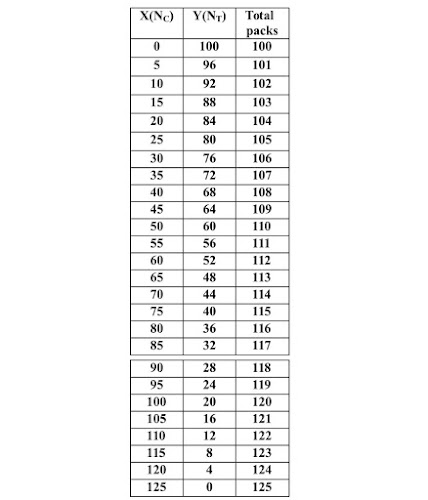
6
The second desired solution enters into the details of the cards contained in the two decks. The above table does not require precise numbers of cards in the two decks, but only that their relationship be of 4/5. Now we must examine which of the "plausible" numbers with 4/5 ratio are preferred.
In fact, the choice is rather limited, as shown in the following table:

From what we know so far, the choice of the number 70 for the deck of triumphs does not create particular problems. There are even historical documents in Ferrara which read precisely of decks of 70 cards for the trumps. Also Lothar Teikemeier has been advancing for years the proposal of a primitive deck of triumph cards of the format 5x14. (5)
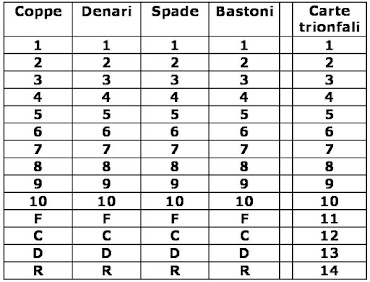
Figura 1 – Schema of the two decks discussed.
7
The question, if need be, concerns the common deck of 56 cards, which cannot be said to be common. After all, the idea of a deck of 56 cards is not entirely unique, because it corresponds in particular to the "normal cards" present precisely inside the tarot decks known from later times, with the number cards from 1 to 10 and the upper four figures: page, knight, queen, king. Among other things, the presence of a pack like that seems already documented in the sermons of San Bernardino, where all four figures are mentioned.
To me, however, it remains difficult to imagine an Italian “common” pack of 56 cards used in "common" games. In Italy, of the four figures as a rule only three are used, choosing either the knight or the queen by region. Also of the ten numeral cards some are eliminated; more often, at least in the sequence, those from 8 to 10 inclusive.
The production of decks of 56 cards then would suggest that they were produced so as to meet the requirements of different locations, in which, if desired, the deck could be reduced in various ways to conform it to the games and to the habits of local players.
The proposed solution does not appear a hundred percent convincing. However, the possible alternatives convince even less, except perhaps that of 12 cards per suit, with a series of only 12 triumphal cards. In this second case, it would probably be easier to accept suits of 12 cards, but the triumphal series of only 12 cards would present itself as a bit too limited from what little we know. The remaining possibilities are even less convincing, although some elements in favor taken in particular cases can be found for almost all, including the ultimate of the deck of 80 cards.
In particular, I am convinced that the above is derived directly from the choice of the number 125 of groups of decks. I do not think that that number is compatible with other solutions based on randomly chosen numbers for the two decks: with any two numbers the numerical coincidence which leads to an equal total number of cards becomes exceptional for different quantities of complete decks of the two types.
Before, I thought that that strange 125 could be the result of a mistake in the transcription of the document; Now, I see rather clearly the technical reasons that had led to its choice.
Conclusion
A 1908 article was re-examined in which important Bolognese documents for the history of playing cards were published for the first time. Data in the documents have been commented on again, as well as the presence in Bologna of German card makers and in Florence of naibi in notarial acts.
On the basis of the number of 125 decks of cards indicated as a reference for production, some arithmetic exercises have been carried out, in order to define the numbers of cards present in decks of [common[ cards and also of triumphs in 1477 Bologna. The two most plausible corresponding numbers were 56 and 70.
Notes
1. Emilio Orioli, Il libro e la Stampa, II (1908), 109-119.
2. http://trionfi.com/0/e/00/
3. Lorenz Böninger, Die deutsche Einwanderung nach Florenz im Spätmittelalter. Leiden-Boston
2006.
4. http://naibi.net/A/64-ORPELLI-Z.pdf
5. http://trionfi.com/0/f/


